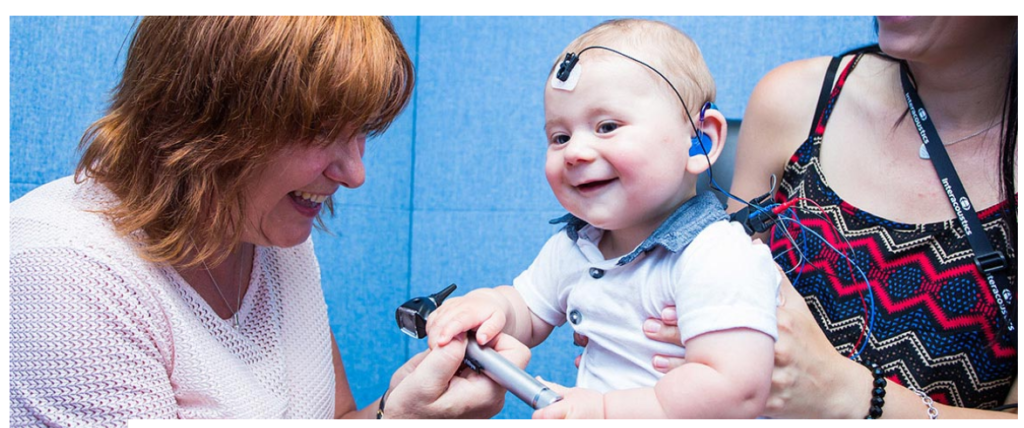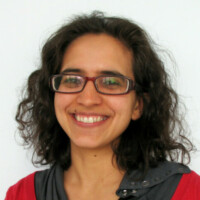How do we know what newborn babies are hearing?
For Deaf Awareness Week Dr Anisa Visram, Research Audiologist at Manchester BRC tells us how the ‘Ladies in the van’ project has been travelling the UK to meet the challenge of finding out how much impact hearing aids have on babies’ hearing.
For babies who are born with permanent hearing loss, hearing aids are fitted within the first three months of their life. However, parents have to wait until their child is around seven to nine months for the next hearing test, to find out just how much of an impact the hearing aids are having, which can result in months of waiting.
Did you know permanent hearing loss affects approximately one in a thousand babies in the UK?
Babies born in the UK have a hearing check within a few days of birth. In a typical week around 13,000 newborn babies will get their hearing checked. Most babies pass the check, but those that don’t (around 200) are seen by an audiologist who investigates their hearing further. The audiologist plays different pitches of sound to the baby through a headphone, and uses sensors placed on the baby’s scalp to pick up brainwave patterns that reveal whether or not the sound was heard. This lets them confirm whether or not the baby really does have a hearing loss. It also provides the information needed to fit hearing aids. These tests are vital as not getting the diagnosis and subsequent help that these babies need could impact on their learning of language, social interaction and education.
How do we know how much babies are really hearing through their hearing aids?
By the time a baby is around seven to nine months old we can use a test procedure that looks like a game where we encourage them to turn towards a sound, and this can be really helpful in letting us know exactly which pitches of sounds are being heard at which levels. Babies get their first hearing aids when they are just a matter of weeks old, so are wearing them for several months before audiologists can check using this turning-to-sounds game.
How do we find out how much speech and conversation is really being heard by these young babies?
This is the challenge our research set out to meet. We wanted to assess babies of three to seven months who wear hearing aids, and try a novel method of determining how well they were hearing. The new test is similar to the one audiologists use for younger babies in that it uses sticky pads on the scalp to remotely pick up changes in brainwaves which occur when we hear a sound. This test is specifically designed to work with speech sounds played whilst babies wear their hearing aids.

Then all we have to do is keep them still and quiet (sometimes easier said than done!) with a few choice toys whilst the computer presents the speech sounds, records the brainwaves and works out if the sounds are being heard.
We wanted to make participation in research possible for families far and wide – so with this study we decided to take the research out to the families. As a result our team has been affectionately dubbed the ‘Ladies in the van’, as we travelled the country in our mobile research unit.
Is it working?
We have promising results for the first type of test (called a ‘cortical’) and are still analysing data on a second similar test (auditory steady-state response). We are now turning our attention to how to get the new tests used in paediatric audiology clinics.
What about life on the road and life under lockdown?
Our mobile research unit has clocked up a whopping 60,000 miles, over nearly four years of visiting families. Due to the lockdown as a result of the COVID-19 pandemic we’re no longer able to visit families. However, we are all working hard from home to analyse the data we have and make preparations for our next projects, including looking at improved remote practices to support patients who cannot visit their audiologists.
The more hours a day babies wear their hearing aids, the better their language outcomes will be. However, our data has highlighted hearing aids are not being worn as often as they should be to achieve the optimum benefits. As a result of our research we have been awarded funding from the National Deaf Children’s Society to begin a study following up on our data. This will address the challenges of incorporating regular hearing aid use into daily life for parents of babies with hearing loss.
We’ve built up a strong network of contacts with paediatric audiologists across the country as a result of our research, and we have been listening closely to their stories of redeployment into different parts of the NHS to help tackle the coronavirus situation. We applaud the collaborative efforts made by our colleagues in clinical audiology to mitigate the effects of the crisis, both for their own patients, and for the wider community.
Facebook: https://www.facebook.com/ladiesinthevan/
